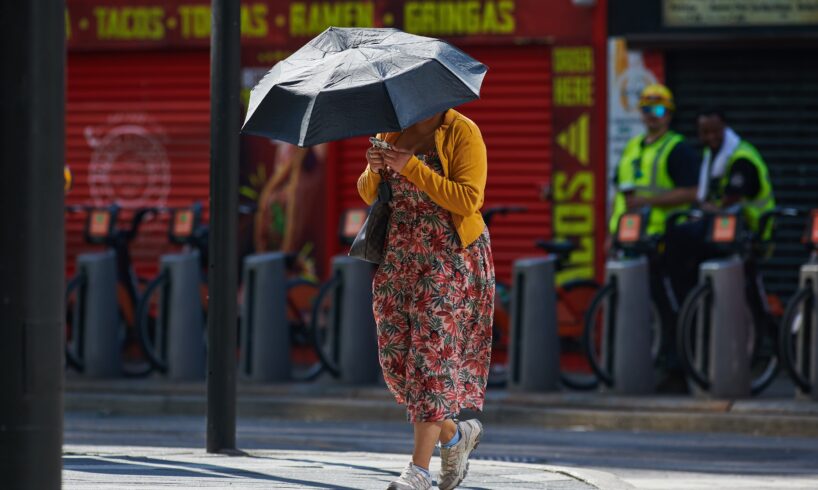
Open this photo in gallery:
Commuters try to stay out of the sun as Toronto grapples with a heat wave on June 23, 2025. According to Health Canada, people with low incomes, people with chronic illnesses and those experiencing homelessness are particularly vulnerable to extreme heat.Sammy Kogan/The Globe and Mail
Toronto has spent more than half the summer so far under heat warnings, according to data from Environment Canada, which show the area has already surpassed the number of extremely hot days in each of the past two years.
Environment Canada meteorologist Steven Flisfeder said the city has been under a heat warning for 21 days so far this summer, with the fifth such warning issued on Monday.
In Toronto, heat warnings are issued when the temperature reaches 31 degrees or higher for two or more consecutive days, while the overnight low remains at 20 degrees or higher.
A warning can also be triggered if the humidex – which measures how humidity makes it feel hotter than the actual temperature – is expected to reach above 40 for two consecutive days, Mr. Flisfeder said.
The current heatwave hit much of Southern Ontario, with daytime temperatures in the low 30s on Monday and humidex values in the low 40s. The heat prompted public-health warnings as local governments implemented emergency plans and hospitals reported an increase in ER visits.
Heat-related emergency-room visits at Toronto hospitals in July have more than doubled this year, compared with visits the same month last year, according to data provided by Toronto Public Health.
The data show there were 51 heat-related emergency-department visits to Toronto hospitals so far this month as of Sunday, compared with 21 in July, 2024, and 16 in July, 2023.
Heat wave blamed for 42 Toronto emergency room visits, public health says
Toronto to review gaps in city’s heat strategy at Mayor Olivia Chow’s request
Health Canada lists people with low incomes, people with chronic illnesses and those experiencing homelessness as particularly vulnerable to extreme heat.
Rev. Maggie Helwig, rector of the Church of St. Stephen-in-the-Fields in Toronto’s Kensington Market, said she’s noticed people who access services at the church seem listless during periods of extreme heat.
Ms. Helwig said the church receives enough donations of water to be able to provide it to those in need. It also has a drop-in program on Friday evenings, and serves breakfast on Saturdays and Sundays.
The church’s yard is currently home to about eight or nine people who live outdoors in an encampment, she said.
“People are clearly unwell and being very badly affected,” Ms. Helwig said, adding that people are dehydrated and visibly sunburnt.
She said that while the city offers cooling centres for those experiencing homelessness, there are still barriers to accessing them, such as the distance required to travel to get to them.
“To get from Kensington Market to Metro Hall in an extreme heat alert is in itself dangerous,” Ms. Helwig said, referring to one of the municipally run cooling centres.
In the short term, she said people need access to water and air-conditioned spaces. However, what vulnerable people really need is access to housing.
“The ultimate answer is not patching up – bandaging – a lot of wounds on the street. The ultimate answer is: Get people into housing,” Ms. Helwig said.
Mr. Flisfeder said there have been more days under heat warnings in Toronto so far this summer than in the past few years, with 16 days last year, 19 in 2023 and 23 in 2022.
Ask a doctor: What are the signs of heat illness?
Presently, the city is trending toward summers similar to 2016 and 2020, when there were seven and eight warnings issued, respectively, Mr. Flisfeder said.
He said the temperature is expected to remain above average for the rest of the summer.
“That doesn’t mean every day or every week we’ll be under a heat event or a heat warning, but generally speaking, when we compare to climatological norms, we’re expecting over all, the rest of the summer to be above seasonal,” Mr. Flisfeder said.
Daytime highs this time of the year should be around 27 degrees in Toronto, he said.
Typically, the daytime highs would go down to the mid-20s halfway through August and would continue to decline as September approaches.
The City of Toronto has a Heat Relief Strategy, which includes a map of cool spaces such as public pools, community centres, splash pads, libraries and more.
Senior communications adviser for the City of Toronto Elise von Scheel said the municipality activates more than 100 additional shelter spaces across the city during heat warnings.
Additional staff who focus on distributing water bottles to people experiencing homelessness, including those in encampments, are also deployed during heat warnings, she said.





